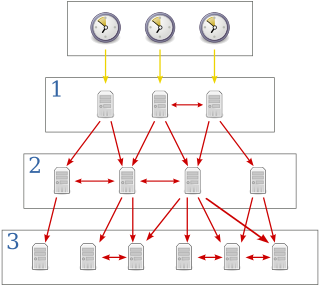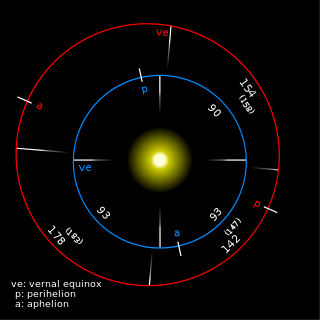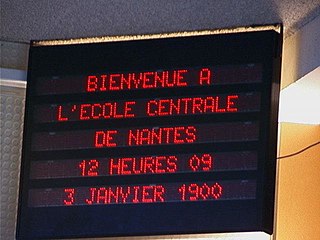Related Research Articles
International Atomic Time is a high-precision atomic coordinate time standard based on the notional passage of proper time on Earth's geoid. TAI is a weighted average of the time kept by over 450 atomic clocks in over 80 national laboratories worldwide. It is a continuous scale of time, without leap seconds, and it is the principal realisation of Terrestrial Time. It is the basis for Coordinated Universal Time (UTC), which is used for civil timekeeping all over the Earth's surface and which has leap seconds.
A calendar date is a reference to a particular day represented within a calendar system. The calendar date allows the specific day to be identified. The number of days between two dates may be calculated. For example, "25 April 2024" is ten days after "15 April 2024". The date of a particular event depends on the observed time zone. For example, the air attack on Pearl Harbor that began at 7:48 a.m. Hawaiian time on 7 December 1941 took place at 3:18 a.m. Japan Standard Time, 8 December in Japan.

ISO 8601 is an international standard covering the worldwide exchange and communication of date and time-related data. It is maintained by the International Organization for Standardization (ISO) and was first published in 1988, with updates in 1991, 2000, 2004, and 2019, and an amendment in 2022. The standard provides a well-defined, unambiguous method of representing calendar dates and times in worldwide communications, especially to avoid misinterpreting numeric dates and times when such data is transferred between countries with different conventions for writing numeric dates and times.

A leap second is a one-second adjustment that is occasionally applied to Coordinated Universal Time (UTC), to accommodate the difference between precise time and imprecise observed solar time (UT1), which varies due to irregularities and long-term slowdown in the Earth's rotation. The UTC time standard, widely used for international timekeeping and as the reference for civil time in most countries, uses TAI and consequently would run ahead of observed solar time unless it is reset to UT1 as needed. The leap second facility exists to provide this adjustment. The leap second was introduced in 1972. Since then, 27 leap seconds have been added to UTC, with the most recent occurring on December 31, 2016.

A time zone is an area which observes a uniform standard time for legal, commercial and social purposes. Time zones tend to follow the boundaries between countries and their subdivisions instead of strictly following longitude, because it is convenient for areas in frequent communication to keep the same time.
The Julian day is the continuous count of days since the beginning of the Julian period, and is used primarily by astronomers, and in software for easily calculating elapsed days between two events.
In chronology and periodization, an epoch or reference epoch is an instant in time chosen as the origin of a particular calendar era. The "epoch" serves as a reference point from which time is measured.
A time standard is a specification for measuring time: either the rate at which time passes or points in time or both. In modern times, several time specifications have been officially recognized as standards, where formerly they were matters of custom and practice. An example of a kind of time standard can be a time scale, specifying a method for measuring divisions of time. A standard for civil time can specify both time intervals and time-of-day.

The Network Time Protocol (NTP) is a networking protocol for clock synchronization between computer systems over packet-switched, variable-latency data networks. In operation since before 1985, NTP is one of the oldest Internet protocols in current use. NTP was designed by David L. Mills of the University of Delaware.

The year 2038 problem is a time computing problem that leaves some computer systems unable to represent times after 03:14:07 UTC on 19 January 2038.
The Common Object File Format (COFF) is a format for executable, object code, and shared library computer files used on Unix systems. It was introduced in Unix System V, replaced the previously used a.out format, and formed the basis for extended specifications such as XCOFF and ECOFF, before being largely replaced by ELF, introduced with SVR4. COFF and its variants continue to be used on some Unix-like systems, on Microsoft Windows, in UEFI environments and in some embedded development systems.
In astronomy, a Julian year is a unit of measurement of time defined as exactly 365.25 days of 86400 SI seconds each. The length of the Julian year is the average length of the year in the Julian calendar that was used in Western societies until the adoption of the Gregorian Calendar, and from which the unit is named. Nevertheless, because astronomical Julian years are measuring duration rather than designating dates, this Julian year does not correspond to years in the Julian calendar or any other calendar. Nor does it correspond to the many other ways of defining a year.

A timestamp is a sequence of characters or encoded information identifying when a certain event occurred, usually giving date and time of day, sometimes accurate to a small fraction of a second. Timestamps do not have to be based on some absolute notion of time, however. They can have any epoch, can be relative to any arbitrary time, such as the power-on time of a system, or to some arbitrary time in the past.

Unix time is a date and time representation widely used in computing. It measures time by the number of non-leap seconds that have elapsed since 00:00:00 UTC on 1 January 1970, the Unix epoch. In modern computing, values are sometimes stored with higher granularity, such as microseconds or nanoseconds.

Though no standard exists, numerous calendars and other timekeeping approaches have been proposed for the planet Mars. The most commonly seen in the scientific literature denotes the time of year as the number of degrees on its orbit from the northward equinox, and increasingly there is use of numbering the Martian years beginning at the equinox that occurred April 11, 1955.
In computer science and computer programming, system time represents a computer system's notion of the passage of time. In this sense, time also includes the passing of days on the calendar.
A Lilian date is the number of days since the beginning of the Gregorian calendar on October 15, 1582, regarded as Lilian date 1. It was invented by Bruce G. Ohms of IBM in 1986 and is named for Aloysius Lilius, who devised the Gregorian Calendar. Lilian dates can be used to calculate the number of days between any two dates occurring since the beginning of the Gregorian calendar. It is currently used by date conversion routines that are part of IBM Language Environment (LE) software and in IBM AIX COBOL.
In computer science, data type limitations and software bugs can cause errors in time and date calculation or display. These are most commonly manifestations of arithmetic overflow, but can also be the result of other issues. The most well-known consequence of this type is the Y2K problem, but many other milestone dates or times exist that have caused or will cause problems depending on various programming deficiencies.

The year 2000 problem, also commonly known as the Y2K problem, Y2K scare, millennium bug, Y2K bug, Y2K glitch, Y2K error, or simply Y2K, refers to potential computer errors related to the formatting and storage of calendar data for dates in and after the year 2000. Many programs represented four-digit years with only the final two digits, making the year 2000 indistinguishable from 1900. Computer systems' inability to distinguish dates correctly had the potential to bring down worldwide infrastructures for computer reliant industries.
References
- ↑ "[MS-DTYP]: FILETIME". Microsoft Docs . 2020-03-30.
- 1 2 3 Spolsky, Joel (2008-02-19). "Why are the Microsoft Office file formats so complicated? (And some workarounds)" . Retrieved 2009-03-08.
- ↑ Dershowitz, Nachum; Reingold, Edward (2008). Calendrical Calculations (3 ed.). Cambridge University Press. pp. xxi, xxvi. ISBN 978-0-521-70238-6.
- ↑ Subirana, J. Sanz; Zornoza, J. M. Juan; Hernández-Pajares, M. (2011). "Time References in GNSS". gssc.esa.int/navipedia. European Space Agency.
- ↑ "GNSS Timescale Description Galileo" (PDF). United Nations Office for Outer Space Affairs. 2016. Section 5d.
- ↑ "datenum", MathWorks, accessed 7 July 2015.
- ↑ "GregorianCalendar Class". MSDN. Remarks. Retrieved 2015-04-26.
- ↑ "DateTimeOffset Structure" (.NET Framework 4.5), MSDN, 2015.
- ↑ "Package time". golang.org. Retrieved 2015-04-26.
- ↑ "Date—z/OS TSO/E REXX Reference". IBM.com. IBM. 2014. SA32-0972-00.
- ↑ Dershowitz, Nachum; Reingold, Edward (2008). "The Gregorian calendar". Calendrical Calculations (3 ed.). Cambridge University Press. ISBN 978-0-521-70238-6.
- ↑ Cowlishaw, Mike Frederic (1990). The Rexx Language: A Practical Approach to Programming (2 ed.). Prentice Hall. pp. 93, 177. ISBN 0-13-780651-5.
- ↑ "Go 1 Release Notes—Major changes to the library—Time". golang.org. 2012-03-28. Retrieved 2015-04-26.
- ↑ "Date and Time Formats". IBM.com. IBM. Retrieved 2020-01-24.
- ↑ "CEEDATM—Convert seconds to character timestamp". z/OS Language Environment Programming Reference. IBM. 2021-03-22.
- ↑ COBOL for AIX Programming Guide Version 5.1 (PDF) (First ed.). IBM. June 2015. CEEDATE—convert Lilian date to character format. SC27-5404-00.
- ↑ Leach, P.; Mealling, M.; Salz, R. (July 2005). "RFC 4122: Proposed Standard: A Universally Unique IDentifier (UUID) URN Namespace". tools.ietf.org. Internet Engineering Task Force.
- ↑ ISO/IEC 1989:2014 - Information technology — Programming languages, their environments and system software interfaces — Programming language COBOL. ISO. 2014-06-01. p. 634.
- 1 2 Chen, Raymond (2009-03-06). "Why is the Win32 epoch January 1, 1601?". The Old New Thing. MSDN Blogs.
- ↑ "FILETIME structure (minwinbase.h)". Microsoft Docs .
- ↑ "What happened in 1841?". M Technology and MUMPS Language FAQ, Part 1/2. Archived from the original on 2015-08-28. Retrieved 2015-08-14.
- ↑ Winkler, Gernot M. R. "Modified Julian Date". U.S. Naval Observatory. Archived from the original on 2013-02-14. Retrieved 2015-01-29.
- ↑ "VMS base time origin". vms.tuwien.ac.at/info/humour. Technische Universität Wien. Archived from the original on 2007-06-06.
- ↑ "Introduction to the Google Sheets API". Google Developers.
- ↑ "International Day Number". help.dyalog.com. Retrieved 2018-11-27.
- ↑ "Time Management". msdn.microsoft.com.
- ↑ "What is story behind December 30, 1899 as base date?". social.msdn.microsoft.com.[ permanent dead link ]
- 1 2 John Barnes. "7.3 Times and dates". Rationale for Ada 2005. Ada Resource Association.
- ↑ "Dates And Times In Excel". cpearson.com.
- ↑ "MacTech – The journal of Apple technology". mactech.com.
- ↑ "Introduction to Dates and Times in SAS" (PDF).
- ↑ Mark Pick, International Spectrum Conference April 2010.
- ↑ "time_t – C++ Reference" . Retrieved 2015-04-06.
- ↑ Barthel, Olaf (September 1998). "File: The Year 2000 Problem and the Amiga". amiga.de.
- ↑ Levine, Judah (2002-07-05). "Time and frequency distribution using satellites" (PDF). Reports on Progress in Physics. 65 (8): 1119. Bibcode:2002RPPh...65.1119L. doi:10.1088/0034-4885/65/8/201 – via National Institute of Standards and Technology (NIST).
- ↑ "Time Systems and Dates – GPS Time". Department of Oceanography, NPS. Naval Postgraduate School, Oceanography Department. Archived from the original on 2019-01-02. Retrieved 2019-02-18.
- ↑ "FIT SDK - Working with Date Time Values". garmin.com. 2023-01-01. Retrieved 2023-02-25.
- ↑ "Flexible and Interoperable Data Transfer - FIT Protocol". garmin.com. 2019-03-01. Retrieved 2023-02-25.
- ↑ "AppleSingle/AppleDouble Formats for Foreign Files Developer's Note" (PDF). Archived from the original (PDF) on 2011-07-17. Retrieved 2007-10-23.
- ↑ "PostgreSQL 9.1.24 Documentation. Chapter 8: Data Types. 8.5. Date/Time Types". PostgreSQL.org. 2016-10-27.
Note: When timestamp values are stored as eight-byte integers (currently the default), microsecond precision is available over the full range of values. […] timestamp values are stored as seconds before or after midnight 2000-01-01.
- ↑ "ZigBee Cluster Library Specification". Section 2.5.2.21 UTCTime.
- ↑ NASA JPL [@NASAJPL] (2021-05-04). "The Force is strong with this little one" (Tweet) – via Twitter.
- ↑ "NeoGPS/src/NeoTime.cpp at master · SlashDevin/NeoGPS". GitHub. Retrieved 2023-11-05.